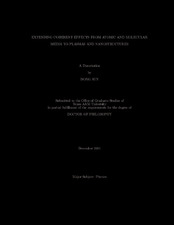| dc.contributor.advisor | Scully, Marlan O. | |
| dc.contributor.advisor | Rostovtsev, Yuri V. | |
| dc.creator | Sun, Dong | |
| dc.date.accessioned | 2012-02-14T22:20:17Z | |
| dc.date.accessioned | 2012-02-16T16:18:18Z | |
| dc.date.available | 2012-02-14T22:20:17Z | |
| dc.date.available | 2012-02-16T16:18:18Z | |
| dc.date.created | 2011-12 | |
| dc.date.issued | 2012-02-14 | |
| dc.date.submitted | December 2011 | |
| dc.identifier.uri | https://hdl.handle.net/1969.1/ETD-TAMU-2011-12-10508 | |
| dc.description.abstract | Quantum coherence and interference(QCI) effects have been studied for decades and are widely exploited in many areas. For media with QCI effect, the optical properties can change drastically, which leads to many interesting effects, such as coherent population trapping, electromagnetically induced transparency(EIT), lasing without population inversion(LWI) and so on.
We have theoretically studied the pulsed regime of EIT. In particular, simulations of propagation of gaussian and 0 - pi co-propagating laser pulses in a medium consisting of 3-level Lambda-atoms have been performed. It has been found that, even at the two-photon resonance, the length of propagation for the 0 - pi pulses is much smaller than that for the Gaussian probe pulses. We explained such a behavior using the dark and bright basis and the dressed state basis. Some possible applications are discussed.
We also investigated the collision-induced coherence of two decay channels along two optical transitions. Quantum interference will suppress the spontaneous emission. The degree of this suppression is measured by the branch ratio of these two transitions. Our preliminary calculations show that a significant decrease of the branching ratio with increase of electron densities is reproduced in the theory.
We have developed a new variant of Raman spectroscopy with shaped femtosecond pulses. It has several advantages to be applied in multiscatterd media. It is based on change of the spectra of femtopulses due to Raman scattering (stimulated or coherent). The technique can be used for a broad range of applications from atomic and molecular optical and IR spectroscopy to spore detection and tissue microscopy.
Finally, we have shown that Fano interference in the decay channels of three levels system can lead to considerably different absorption and emission profiles. We found that a coherence can be built up in the ground state doublet whose strength depends on a coupling parameter that arises from Fano interference. This can in principle lead to breaking of the detail balance between the absorption and emission processes in atomic systems. | en |
| dc.format.mimetype | application/pdf | |
| dc.language.iso | en_US | |
| dc.subject | Quantum Coherence | en |
| dc.subject | Electromagnetically Induced Transparency | en |
| dc.subject | Raman Scattering | en |
| dc.subject | Branching Ratio | en |
| dc.subject | Fano Interference | en |
| dc.title | Extending Coherent Effects from Atomic and Molecular Media to Plasmas and Nanostructures | en |
| dc.type | Thesis | en |
| thesis.degree.department | Physics and Astronomy | en |
| thesis.degree.discipline | Physics | en |
| thesis.degree.grantor | Texas A&M University | en |
| thesis.degree.name | Doctor of Philosophy | en |
| thesis.degree.level | Doctoral | en |
| dc.contributor.committeeMember | Chen, Goong | |
| dc.contributor.committeeMember | Welch, George R. | |
| dc.contributor.committeeMember | Zubairy, Suhail M. | |
| dc.type.genre | thesis | en |
| dc.type.material | text | en |


